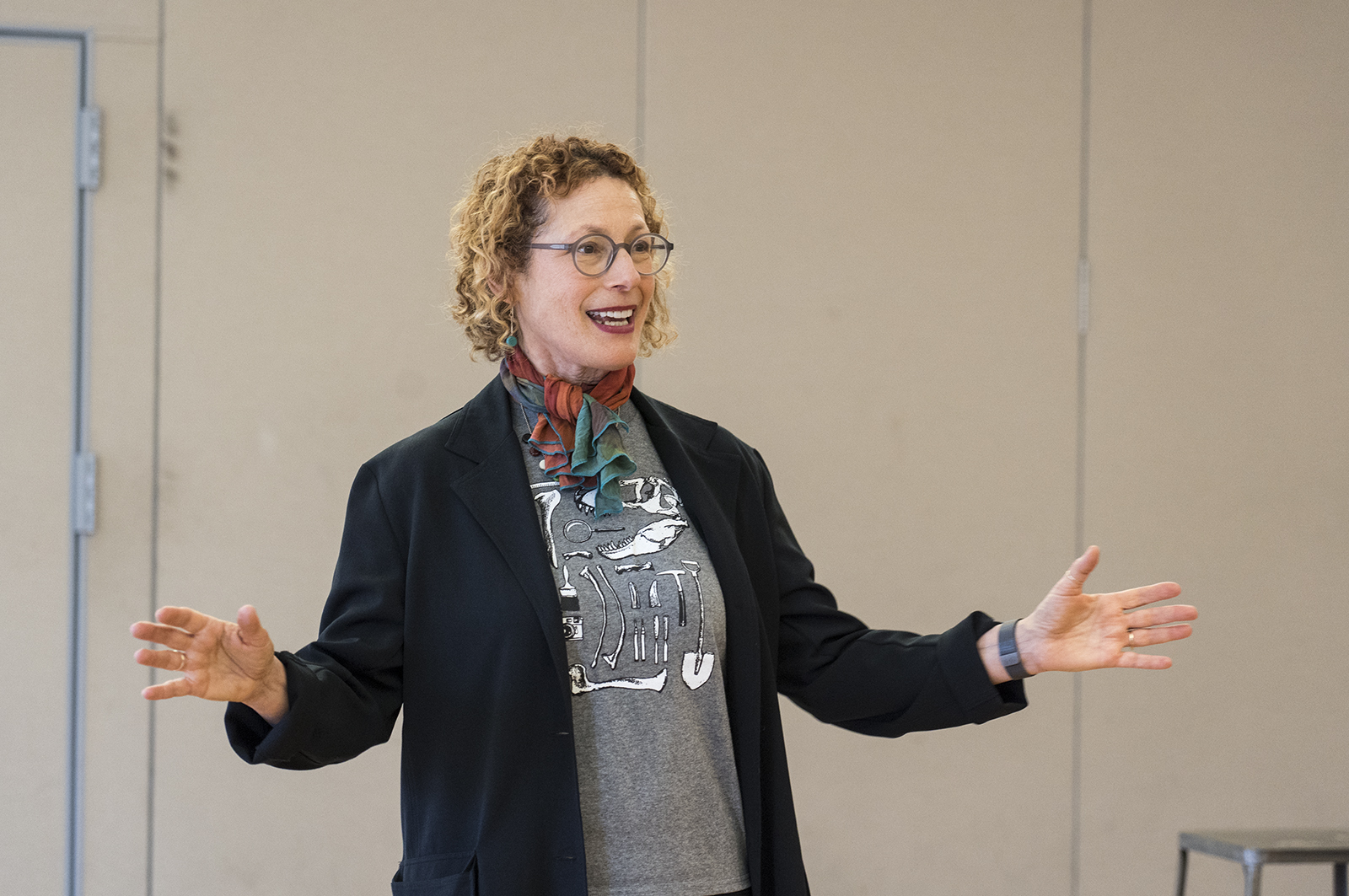Middle Eastern instruments vocalize underlying themes in UCLA Hillel play

Stacie Chaiken wrote and will perform in “The DIG” which will be presented Tuesday in Glorya Kaufman Hall. The one-woman play follows genetic archaeologist Sally Jenkins as she travels to Israel to solve the mystery behind a 4,000-year-old tomb. (Elise Tsai/Daily Bruin)
"The Dig"
Tuesday, April 30
Glorya Kaufman Hall
Free with RSVP
By Katelyn Olsen
April 29, 2019 11:00 p.m.
This post was updated May 14 at 4:45 p.m.
The saz – a Middle Eastern instrument with a long, ornamented neck – gives voice to a lizard in a one-woman play.
The Dortort Center for Creativity in the Arts at UCLA Hillel will present “The DIG” on Tuesday in collaboration with the Younes and Soraya Nazarian Center for Israel studies. The play acts as writer Stacie Chaiken’s response to her year-and-a-half residency in Israel starting in 2003. Interacting with Israel’s history, the play follows genetic archaeologist Sally Jenkins, played by Chaiken, as she travels to Jaffa to solve the mystery behind a 4,000-year-old tomb. Having originally premiered in 2016, this rendition features the debut of Yuval Ron’s original music composition, which he will perform live alongside Chaiken’s performance. The music serves as a subconscious voice, emphasizing emotions, history and the multicontinental locations in the play, Chaiken said.
“(The music) gives a voice to the land, and it gives a voice to things that are buried in that land or buried in time around that land,” Chaiken said.
Chaiken imagined the second voice of the play – one that changes according to a scene’s content – to feature an oud’s big-bellied and resonant sound. As a result, the music is primarily played on this Middle Eastern nylon-stringed instrument. But to signify the presence of Sally’s best friend, Mo the lizard, Ron plays a saz, which has metal strings. Since the lizard is the only animal character, the instrument conveys a brighter, metallic sound, differentiating the lizard’s theme from that of the human characters.
[RELATED: Past bleeds into present in Hillel at UCLA’s newest art exhibits]
The composition is organized in musical themes; each creates a specific sound for different topics. For instance, the Middle Eastern land theme is composed in maqam hijaz – an ancient Middle Eastern musical mode. This mode utilizes midrange notes and a grounding pedal bass to express yearning and tragedy, reflecting on Israel’s violent history, Ron said.
Director Pamela Berlin, who has been working with Chaiken on the play for 10 years, said Ron’s use of the musical motifs supports the thematic ideas in the play without overwhelming Sally’s story. Ron varies the volume as well as implements simple compositions at certain moments to enhance the text instead of overwhelming it, Berlin said.
“His treatment of (the themes) is wonderfully subtle – it doesn’t jump out at you, it doesn’t scream at you, it makes its way down into your … subconscious,” Berlin said.
Ron said the composition is meant to emphasize the underlying emotions in each scene. When there is tension between Sally and her mother, for example, the music conveys that strain through an intense buildup, complete with rapid strumming and increased usage of dissonance, Ron said. Additionally, he uses a deepening set of sounds to create a sense of impending trouble as Sally descends into the tomb. Because Sally is a very guarded character, the music is able to convey an intimacy unapparent in Sally’s relations with other people, Berlin said.
“Having the music play under her I think has really helped to reveal who she is deep down, which is in fact a very vulnerable person,” Berlin said.
[RELATED: Play highlights marginalized experiences of gay men during the Holocaust]
The music also indicates the attitudes of other characters without them being physically present. Ron constructed his responses through musical devices like melodic motifs and slides. When Sally talks to a skeleton, believed to be the remains of the biblical Sarah, the music answers the lines to allude to a dialogue between a living human and a dead human, Ron said.
Ron converses with Chaiken through the music from his place on stage, but never actually looks at the actress. This ensures he does not become an audience member and allows him to treat her voice and breath as music, instead of responding to visual cues. The music and the monologues contrast each other in the music’s emotions and Sally’s cold demeanor, even when discussing painful events, Ron said.
“The music doesn’t really support Sally most of the time; rather, the music supports the world around Sally – the world that she gets trapped in,” Ron said. “The music has its own wisdom.”

